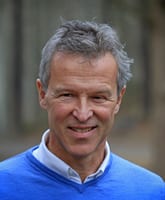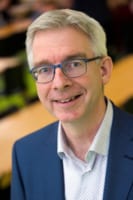Lars Berglund
Wallenberg Wood Science Center, KTH – Royal Institute of Technology, Stockholm, Sweden
|
Topic
Transparent wood
Biography
Lars Berglund is professor at the Royal Inst of Technology in Stockholm, and director of Wallenberg Wood Science Center for New Materials, with an annual funding of 7 million euro. He has been a visiting researcher at Stanford University, Cornell University and Kyoto University. His research interest is in nanostructured composite materials; primarily those based on cellulose. An important challenge is transparent cellulosic nanomaterials, which also can serve as load-bearing engineering materials. Professor Berglund has published more than 200 journal papers, examined more than 20 PhD’s and is a member of the Royal Swedish Academy of Engineering Sciences. He holds an ERC Advanced Grant on Nanotechnologies for Transparent Wood.
|
Silvano de Franceschi
CEA-INAC, Grenoble, France

|
Topic
Quantum prospects for silicon nanoelectronics
Biography
Dr. S. De Franceschi is an expert in quantum nanoelectronics. His experimental research focuses on silicon-based quantum spintronics and hybrid superconductor-semiconductor systems. He received his PhD in 1999 at the Scuola Normale Superiore of Pisa and, since 2007, he has a position of staff scientist at CEA-INAC. In 2005, he was awarded the Kurti European prize for his sustained achievements in the field of quantum transport and, in particular, his works on the Kondo effect in quantum dots and on hybrid normal/superconductor nanostructures. He has obtained several research grants, including a Junior Chair of Excellence Grant from the French Agency for Research (2007-2011), and a European Starting Grant (2012-2017).
|
Chennupati Jagadish
Australian National University, Canberra, Australia

|
Topic
Semiconductor Nanowires for Optoelectronics and Energy Applications
Abstract
Semiconductors have played an important role in the development of information and communications technology, solar cells, solid state lighting. Nanowires are considered as building blocks for the next generation electronics and optoelectronics. In this talk, I will introduce the importance of nanowires and their potential applications and discuss about how these nanowires can be synthesized and how the shape, size and composition of the nanowires influence their structural and optical properties. I will present results on axial and radial heterostructures and how one can engineer the optical properties to obtain high performance lasers, THz detectors and solar cells. Future prospects of the semiconductor nanowires will be discussed.
Biography
Professor Jagadish is a Distinguished Professor and Head of Semiconductor Optoelectronics and Nanotechnology Group in the Research School of Physics and Engineering, Australian National University. He has served as Vice-President and Secretary Physical Sciences of the Australian Academy of Science during 2012-2016. He is currently serving as President-Elect of IEEE Photonics Society, President of Australian Materials Research Society. Prof. Jagadish is an Editor/Associate editor of 6 Journals, 3 book series and serves on editorial boards of 19 other journals. He has published more than 900 research papers (620 journal papers), holds 5 US patents, co-authored a book, co-edited 13 books and edited 12 conference proceedings and 17 special issues of Journals.
|
Albert Polman
Center for Nanophotonics, AMOLF, and University of Amsterdam, Amsterdam, the Netherlands

|
Topic
Nanoscale (in)coherent optical excitations in the electron microscope
Biography
Albert Polman’s research focuses on nanophotovoltaics, the study of light management at the nanoscale to realize solar cells with ultra-high efficiency that can be made at low costs, and develops cathodoluminescence spectroscopy as a super-resolution imaging technique for nanophotonics. He has published over 300 papers that have been cited 30.000 times. Polman is member of the Royal Netherlands Academy of Sciences and recipient of ERC Advanced Investigator Grants (2011, 2016) and several other prizes/awards.
|
Heike Riel
IBM Research, Switzerland

|
Biography
Dr. Heike Riel is IBM Fellow and Director of IoT Technology and Solutions at IBM Research. She is responsible for a research agenda, which aims to create scientific and technological breakthroughs to differentiate IBM’s IoT technology and solutions. This comprises the science and technology for cognitive analytics and IoT, end-to-end IoT applications as well as AI-based solutions for Industry 4.0. She is a distinguished expert in nanotechnology and nanosciences and focuses her research on advancing the frontiers of information technology through the physical sciences. Her research has contributed to advancements in OLED display technology, molecular electronics and semiconductor nanoscale materials and devices. Her recent research interests include topological states of compound semiconductor nanowires for quantum information processing. Her work has led to more than 130 peer reviewed publications, more than 50 patents, as well as a number of major awards.
|
Luisa Torsi
University of Bari, Bari, Italy

|
Topic
Ultra-sensitive detection of clinically relevant biomarkers
Biography
Torsi is professor of chemistry at the University of Bari and adjunct professor at Abo Academy University. She received her laurea degree in Physics and the PhD in Chemical Sciences from UNIBA and was post-doctoral fellow at Bell Labs in USA. She is the past-president of the European Material Research Society, being the first women to hold this role. She is also the only women awarded with the H.E. Merck prize and she is the recipient of the Global-Women Inventors and Innovators Network platinum prize. Recently, she was also elected Fellow of the Material Research Society and awarded with the Distinguished Women Award by the International Union of Pure and Applied Chemistry. Torsi has authored almost 200 ISI papers and is co-inventor of several international awarded patents. Her works gathered almost 11.000 Google scholar citations resulting in an h-index of 50.
|
Alex Zunger
University of Colorado, Bolder, USA

|
Biography
Prof. Alex Zunger of the University of Colorado, Boulder research field is Condensed Matter Theory of Real Materials, involving foundational work on Density Functional Theory, Pseudopotential theory, Quantum Nanostructures, Photovoltaic materials and Materials by Design. He is the recipient of many awards related to material theory and research. He received his Ph.D. from Tel-Aviv University, Tel Aviv Israel where he worked with Prof. Joshua Jortner and Binyamin Englman on quantum theory of molecular solids. He did his postdoctoral research at the Physics Dept. of Northwestern University (with Art Freeman). He then received the IBM Fellowship, which he spent at the Physics Dept. of U.C. Berkeley (with Marvin Cohen). Dr. Zunger established the Solid State Theory group at the National Renewable Energy Laboratory (NREL) Golden, Colorado, and has been the founding Director of the ‘Center for Inverse Design’. He has authored more than 600 articles in refereed journals.
|